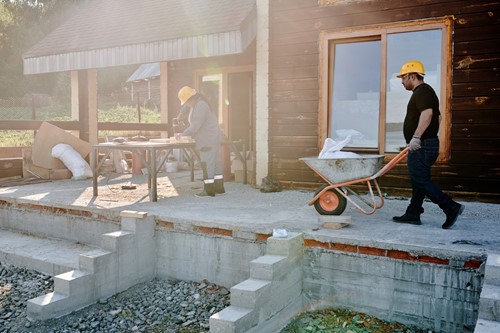
In both existing homes and new construction, there are several common types of foundations for houses. Each has their advantages and disadvantages, including specific maintenance requirements and climate-specific considerations.
Whether you’re building a new home or want to learn more about how to care for your existing home, it’s worth exploring the three major types of foundations used for houses:
Basement foundation
Basement foundations are essentially holes dug beneath the house, matching most or all of the ground-level square footage. Builders use concrete footings around the edge of the basement space as a frame for the foundation, then follow with beams, walls and a concrete slab at the bottom.
Basement foundations can add extra living space to the home, potentially doubling the square footage if finished. Otherwise, unfinished basements serve as valuable storage space and shelter in case of extreme weather.
Concrete slab foundation
Concrete slab foundations are made of a simple, flat layer of concrete situated slightly below the surface of the ground. This is one of the simplest foundation types to install, involving a wire mesh and reinforcing bars within the concrete for extra stability.
Slab foundations are best for warmer regions, as frozen ground can cause cracks and shifts in the concrete. However, in the right conditions, a slab foundation will not develop weak spots or crumble over time.
Crawl space foundation
Crawl space foundations have characteristics of both a basement and a slab foundation. They’re built using small concrete footings called stem walls, which create a slightly elevated space beneath the home. While you can’t use a crawl space as living space, it can be perfect for storage and access to plumbing or electrical wiring.
Crawl space foundations can help keep the home safe from flood damage, earthquake damage and termites. One disadvantage of this foundation type is the vulnerability to mold, mildew and pests who might like to make the shelter their home.
There are other types of foundations, like wood foundations and pier foundations, which are typically more specific to certain regions and types of home. There are also variations of the foundations found in this article, such as slab on grade foundations and daylight basements.
Regardless, the more you know about these three common types of concrete foundation, the more prepared you’ll be to take care of your own - whether in your current home or brand-new construction.
About the Author

Liliya Sherman
Liliya Sherman has been in the Real Estate business for a number of years. She's had great success and her clients are always satisfied. Liliya comes from a business background. She holds a B.S. in Business Administration. She is well organized and results-oriented. Having worked in the high tech industry, Liliya appreciates the importance of managing her and other people's time. She will listen to your needs and will do her best to match them with market opportunities. Liliya holds her clients' interests close to the heart. People who work with Liliya always feel as if they are her number one priority. Don't be left behind.
